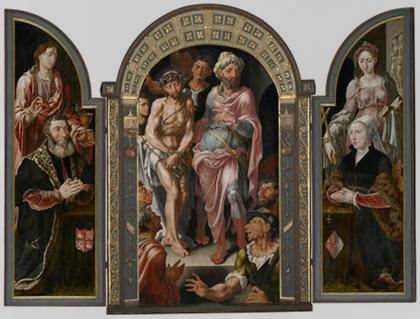
Ecce Homo, 1544.
Maerten van Heemskerck, (Netherlandish, 1498–1574).
Oil on panel. Center panel: 74 1/2 x 52 ¼ inches framed; left wing: 72 1/4 x 24 5/8 inches; right wing: 74 1/4 x 25 ½ inches.
Muzeum Narodowe w Warszawie
Heemskerck’s ‘Ecce Homo’ altarpiece at the Getty Maerten van Heemskerck’s dramatic ‘Ecce Homo’ altarpiece (1544) is presented at the J. Paul Getty Museum in a focused exhibition from June 5, 2012 through January 13, 2013.]]>
Source: J. Paul Getty Museum
Maerten van Heemskerck worked in an innovative style that combined Netherlandish characteristics of verisimilitude with an expressive formal language and use of brilliant color that was influenced by the artist’s time in Italy, where he studied both ancient art and the work of his Italian contemporaries such as Michelangelo.
The Ecce Homo decorated the family chapel of wealthy sheriff Jan van Drenckwaerdt in the Augustinian church in Dordrecht, the Netherlands, between about 1544 and 1572. The altarpiece, which is more than 6 feet wide when fully opened, features five scenes: the central panel depicts the Ecce Homo, a popular subject in Renaissance art; the left interior wing features the patron, Jan van Drenckwaerdt and St. John the Evangelist; Jan’s wife, Margaretha de Jonge van Baertwyck and St. Margaret of Antioch appear on the right interior wing; and St. John the Evangelist and St. Margaret of Antioch are painted in grisaille on the left and right exterior panels. The triptych retains its original 16th-century frame.
Many of Heemskerck’s religious paintings were destroyed by Protestant iconoclasts who attacked churches and destroyed objects associated with the Catholic faith across the Netherlands in 1566. The Ecce Homo triptych stands out as an important survivor of that tumultuous period.
“By bringing the Ecce Homo altarpiece to Los Angeles we have been able to conserve this important work, study it in depth, and now make it possible for our visitors to experience this striking object firsthand. Conservation and technical analysis can transform our understanding of the original appearance of a work of art like Ecce Homo as well as our knowledge of the artist’s technique,” explained Yvonne Szafran, senior conservator of paintings at the Getty Museum.
Related content
Germanic drawings, 1770—1900, at Getty Museum (exhibition, 2011)
Follow us on:


